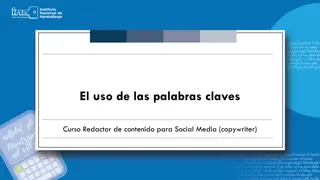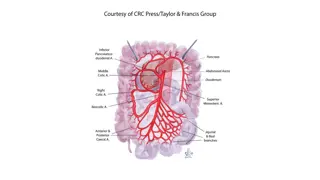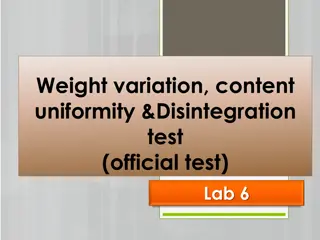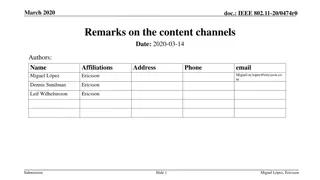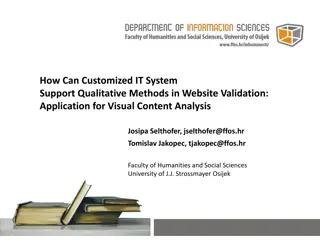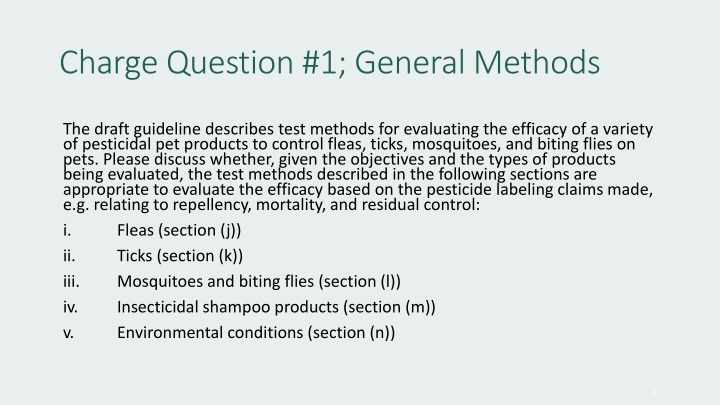
Methods for Evaluating Efficacy of Pesticidal Pet Products
The draft guideline discusses test methods for evaluating the efficacy of various pesticidal pet products targeting fleas, ticks, mosquitoes, and biting flies on pets. It assesses the appropriateness of test methods for evaluating claims such as repellency, mortality, and residual control. Additionally, it explores potential alternative methodologies to reduce or replace the use of animals in testing and ways to refine testing methods to minimize animal suffering. The guideline also considers protocols for testing ear mites and Sarcoptic mange mites and evaluates sample sizes for vertebrate test animals and numbers of arthropod pest species.
Download Presentation

Please find below an Image/Link to download the presentation.
The content on the website is provided AS IS for your information and personal use only. It may not be sold, licensed, or shared on other websites without obtaining consent from the author. If you encounter any issues during the download, it is possible that the publisher has removed the file from their server.
You are allowed to download the files provided on this website for personal or commercial use, subject to the condition that they are used lawfully. All files are the property of their respective owners.
The content on the website is provided AS IS for your information and personal use only. It may not be sold, licensed, or shared on other websites without obtaining consent from the author.
E N D
Presentation Transcript
Charge Question #1; General Methods The draft guideline describes test methods for evaluating the efficacy of a variety of pesticidal pet products to control fleas, ticks, mosquitoes, and biting flies on pets. Please discuss whether, given the objectives and the types of products being evaluated, the test methods described in the following sections are appropriate to evaluate the efficacy based on the pesticide labeling claims made, e.g. relating to repellency, mortality, and residual control: i. Fleas (section (j)) ii. Ticks (section (k)) iii. Mosquitoes and biting flies (section (l)) iv. Insecticidal shampoo products (section (m)) v. Environmental conditions (section (n)) 1
Charge Question #2; General Methods New approach methodologies (NAMs) is a broadly descriptive reference to any non-animal technology, methodology, approach, or combination thereof that can be used in this case for efficacy purposes. EPA seeks to reduce the number of vertebrate animals needed for testing, where possible, while ensuring confidence in test results. a. For each of the following sections from the guideline, please discuss potential alternative methods, including ways to reduce or replace, the use of animals in testing: i. Fleas (section (j)) ii. Ticks (section (k)) iii. Mosquitoes and biting flies (section (l)) iv. Insecticidal shampoo products (section (m)) v. Environmental conditions (section (n)) b. Considering the importance of accurate animal behavior (e.g., grooming) during these tests and confidence in the results of these tests for protecting public health, for each of the following sections of the guideline please discuss methods for refining, e.g., reduce the pain and suffering, the use of animals. i. Fleas (section (j)) ii. Ticks (section (k)) iii. Mosquitoes and biting flies (section (l)) iv. Insecticidal shampoo products (section (m)) v. Environmental conditions (section (n)) 2
Charge Question #3; General Methods Should protocols for testing ear mites and Sarcoptic mange mites be included in the guideline? a. Why or why not? b. If so, please provide appropriate detailed test methods for evaluating the efficacy against these pests for on-animal treatments. 3
Charge Question #4; General Methods For each section listed below, comment on the proposed sample sizes for vertebrate test animals (e.g., dogs, cats). EPA recommends these numbers based on the power vs. sample size analysis provided to ensure adequate power using the minimum number of vertebrate animals. Are these numbers of animals practical? a. Fleas (section (j)) b. Ticks (section (k)) c. Mosquitoes and biting flies (section (l)) 4
Charge Question #5; General Methods For each section listed below, comment on the proposed numbers of different arthropod pest species. EPA recommends these numbers based on review of studies available in the literature studies submitted to EPA, and analysis of power vs. sample size. Are there ways to reduce the number of pests used per test? a. Fleas (section (j)) b. Ticks (section (k)) c. Mosquitoes and biting flies (section (l)) 5
Charge Question #6; General Methods Comment on the timing of exposing vertebrate test animals to fleas and ticks. a. Are the number of exposures for products with different durations of efficacy adequate for determining efficacy? Why or why not? b. If the number of exposures to pests can be decreased, please indicate specifically which exposures can be skipped. If efficacy should be evaluated at more timepoints, indicate when exposures should occur and for what product types (e.g., spot- ons, collars, and residual shampoos), and discuss the value provided by the additional time points. 6
Charge Question #7; General Methods In the interest of reducing the use of vertebrate animals in testing, we have suggested in the guideline to allow testing of up to two species simultaneously for fleas and ticks (e.g., fleas and 1 tick species, 2 tick species). Are there any potential known interactions between multiple tick species or ticks and fleas if on a single vertebrate animal at the same time which would require individual pest species be tested separately? If there are interactions, please describe the interactions and provide references. 7
Charge Question #8; General Methods For pet collars, one of the typical methods of application requires cutting the collar to size and therefore the collar application rates are often dependent on neck size and not animal s weight as for other pet products like spot-ons that have dosing labeled based on weight ranges. Because neck size may not correlate with body weight or surface area, there is uncertainty that testing with the formulated collar sized for the neck may not represent the most conservative situations encountered in the field (e.g., dog breeds with small necks but relatively big bodies). Please discuss how application rate should be addressed during testing of collars. Is cutting the formulated collar to neck size sufficient for testing, even though the typical breeds used in testing may not represent the most conservative ratio of neck size to body weight/surface area? Why or why not? If not, how should this issue be practically addressed during testing? 8
Charge Question #9; General Methods Historically the agency has requested studies for fleas, ticks, and mosquitoes on pets be conducted with 6 to 8 animals per treatment, although, the agency has received studies with sample sizes ranging from 2 to 12 animals per treatment. Based on the statistical simulations provided in Appendix 1, EPA is proposing a minimum number of vertebrate animal subjects for each test type (i.e., pest) in the guideline. This number varies according to test type, ranging from 6 to 14, and is intended to achieve 80% statistical power (confidence) with a precision of 4 or 5%, depending on the specific methods employed for each pest. Please discuss and provide comment on: a. The appropriateness of statistical methods to analyze the data and calculate percent efficacy and the associated 95% confidence interval. b. The appropriateness of statistical methods and simulations EPA has developed to estimate the power of the proposed design, and specifically to achieve an adequate estimate of precision around the estimated mortality/repellency in the treated group for each section below: i. Fleas (section (j)) ii. Ticks (section (k)) iii. Mosquitoes and biting flies (section (l)) c. The assumptions used to inform the simulations (e.g., minimum blood-feeding rate of mosquitoes on control test animals, number of pests per animal) for each section. Specifically, please discuss any information that can be used to update or clarify these assumptions, especially where doing so would increase power with a smaller sample size (i.e., using fewer animals). Where possible, indicate which assumptions can be changed for each pest species or type of test animal and provide value estimates. i. Fleas (section (j)) ii. Ticks (section (k)) iii. Mosquitoes and biting flies (section (l)) 9
Charge Question #10; General Methods Please provide comments on the overall clarity, accuracy, and completeness of the draft pet product guidelines. Please provide any additional comments that highlight areas of the draft guidelines that may need to be clarified and note any critical topics that are missing. Please include references to published literature that could help improve the completeness and clarity of the draft guidelines. 10
Charge Question #11; Fleas (Section (j)) The proposed studies currently are not blinded but untreated controls are used. a. Should the study be blinded and/or utilize an inert control (i.e., formulation minus active ingredient)? b. Why or why not? 11
Charge Question #12; Fleas (Section (j)) Repellency is typically determined by whether or not an insect takes a blood meal. Based on flea feeding behavior, repellency is not considered relevant for flea control and therefore is not included in the guideline. a. Please discuss whether repelling fleas is a viable endpoint. Why or why not? b. If repellency can be considered a viable endpoint, please provide detailed methods to test for repellency against fleas. c. Can repellency be determined by assessing the number of live fleas on treated vs. untreated animals? If so, can repellency based on counts of live fleas on treated vs. untreated animals be differentiated from mortality, which is also currently measured by counts of live fleas on treated vs. untreated animals? If the two endpoints can be differentiated please describe the methods, including specifically how and why the counts of live fleas on treated vs untreated animals differ for repellency and mortality, and provide literature references. 12
Charge Question #13; Ticks (Section (k)) The guideline states that tick infestations should consist of a 50:50 ratio of male to female ticks for all species. The European guideline contains a clause that for Ixodes spp. infestations the sex ratio should consist of approximately 10% males: 90% females since males do not readily attach (Marchiondo et al. 2013). However, the scientific literature for Ixodes spp. appears to be split between using a 50:50 ratio or a 90:10 ratio. Please discuss the merits of each ratio: a. Is one of the ratios better for testing Ixodes spp., or are they both appropriate? If one ratio is better than the other, please explain why. b. Is one of the ratios better for testing Rhipicephalus spp., or are they both appropriate? If one ratio is better than the other, please explain why. c. Is one of the ratios better for testing Amblyomma spp., or are they both appropriate? If one ratio is better than the other, please explain why. 13
Charge Question #14; Ticks (Section (k)) The guideline states that ticks that feed to engorgement can transmit pathogens that may cause disease; therefore, mortality after blood- feeding to the point of engorgement should not be considered a viable endpoint. a. Is the determination of engorgement a feasible data collection point? Why or why not? b. If so, please provide detailed methods with references for determining engorgement. c. Can blood feeding be determined prior to engorgement and would this be a viable endpoint? If so, please describe methods for determining blood feeding prior to engorgement and provide any relevant references. 14
Charge Question #15; Ticks (Section (k)) The endpoints for repellency and mortality contain numerous different categories which define how ticks should be recorded for each endpoint (e.g., repellency). a. Are there any additional categories which might be needed for the different endpoints (e.g., repellency)? Is the separate presentation of the endpoints clear? b. Can both repellency and mortality be assessed in a single study, or does each endpoint need to be assessed separately? Please explain. 15
Charge Question #16; Mosquitoes/Flies (Section (l)) Comment on the adequacy of outcrossing lab-reared colonies of mosquitoes every 3 years. a. Is three years an adequate timeframe to retain genetic diversity in lab-reared populations? Why or why not? b. If not, how often should lab-populations be outcrossed with wild-type mosquitoes? Please provide references if relevant. 16
Charge Question #17; Mosquitoes/Flies (Section (l)) In the interest of reducing vertebrate animal testing, we propose simultaneous testing of up to three mosquito species on a single vertebrate animal. a. Is simultaneous testing of three mosquito species feasible? Why or why not? b. If simultaneous testing of three mosquito species on a single vertebrate animal is feasible, then please comment if the proposed methods are adequate, and if there are alternative methods please provide detailed methods and references. c. If testing three species at once is not feasible, provide additional detailed methods and associated references to limit the number of vertebrate test animals necessary to complete efficacy testing against the three required mosquito species and maintain adequate statistical power. 17
Charge Question #18; Mosquitoes/Flies (Section (l)) The proposed methods to test mosquitoes and biting flies indicate vertebrate test animals should be sedated prior to exposure to invertebrate pests. a. In the interest of minimizing stress of sedation on vertebrate test animals please discuss whether sedation is necessary. If sedation is not necessary, please provide detailed methods and references and discuss the strengths and weaknesses of the methods for conducting efficacy testing. b. If sedation is necessary, please provide methods to minimize the number of times vertebrate animals should be sedated. 18
Charge Question #19; Mosquitoes/Flies (Section (l)) Comment on the timing of exposing vertebrate test animals to mosquitoes and biting flies. a. Are the number of exposures for products with different durations of efficacy adequate for determining efficacy? Why or why not? b. If the number of exposures to pests can be decreased, please indicate specifically which exposures can be skipped. If efficacy should be evaluated at more timepoints, indicate when exposures should occur and for what product types (e.g., spot- ons, collars, and residual shampoos), and discuss the value provided by the additional time points in relation to the additional stress on test animals from additional sedations. 19
Charge Question #20; Mosquitoes/Flies (Section (l)) Comment on the methods for assessing mosquito and biting fly blood-feeding. a. Are the proposed methods adequate to determine blood feeding for insects where blood feeding status cannot be visually observed through the abdomen? b. Are there other methods for determining if insects blood-feed? If so, please provide additional methods and references. 20
Charge Question #21; Mosquitoes/Flies (Section (l)) To reduce the amount of vertebrate animal testing, we propose to allow assessment of repellency and mortality within the same study by evaluating half of the insects for repellency before determining mortality. a. Discuss the viability of evaluating both endpoints in the same study by using a subset of the total mosquitoes to determine repellency, and provide any additional methods that would determine both endpoints within the same study. b. The proposed endpoints for mortality are secondary to repellency (i.e., for mortality to be assessed repellency should be observed first) because a mosquito or fly that is not repelled may blood-feed and could potentially transmit pathogens that cause disease. Discuss the potential value of assessing mosquito mortality that are not also repelled. Should mortality of mosquitoes that blood-feed be considered a viable endpoint to show efficacy of a repellent- product? Why or why not? If yes, provide specific rationale as to why. 21
Charge Question #22; Shampoos (Section (m)) Efficacy testing is based on the specific label claims proposed for product marketing. Common claims are kills, repels, and controls (i.e., residual efficacy). For most pesticide products (e.g., direct sprays and residual applications) the typical endpoint to support claims of kills or controls is based on dead arthropods. To evaluate dead arthropods for shampoo products we propose pests should be shampooed in a tub with a screen over the drain to keep fleas and/or ticks in the tub. This may differentiate the pesticidal effect from the effect of pest removal, which could also occur by using a non-insecticidal shampoo. Discuss the value of using counts of dead arthropods vs. using counts of live arthropods on treated compared to untreated vertebrate animals to determine different endpoints (e.g., kills). a. Is assessing live arthropods on treated vs. untreated animals an adequate and practical endpoint for determining mortality? Why or why not? b. Are there alternative methods for determining mortality for shampoo products? If so please provide the methods and supporting references. 22
Charge Question #23; Shampoos (Section (m)) Typically, efficacy testing for pet products is conducted with a treated group and an untreated control group. To determine efficacy of shampoo products, the mechanical removal of arthropods during the shampoo process should be considered. Efficacy of a product would therefore be considered in relation to a group treated with non-insecticidal shampoo. In this guideline we propose a non-pesticidal/non-medicated shampoo as the control when testing insecticidal shampoo products. a. Please discuss the value of using a non-pesticidal/non-medicated shampoo as the control i. Does this provide valuable additional information about efficacy beyond an untreated control? ii. If so, please provide an appropriate methodology for the comparison of treatment vs. control groups, including references. b. Should an untreated control also be provided for comparison with the non-pesticidal shampoo? If so, please describe the most appropriate untreated control (e.g., water only, massaging the animal). What is the value of the untreated control and is the informational value of an additional treatment group offset by the increased number of vertebrate animals used for testing? c. If an untreated control group is included, how should efficacy be determined? Which control group (the non-insecticidal shampoo control or the untreated control) should be compared with the treated group to determine efficacy? 23
Charge Question #24; Env Conditions (Section (n)) Discuss whether the timing for infesting vertebrate test animals after water exposure are adequate. a. Are the number of infestations presented in the guideline adequate to support bathing and water immersion claims? b. Discuss appropriate timing of infestations after vertebrate test animals are immersed in water. c. Are the methods for determining exposure to sunlight adequate? If not, please provide detailed methods for evaluating the effects of exposure to sunlight along with supporting references. 24


